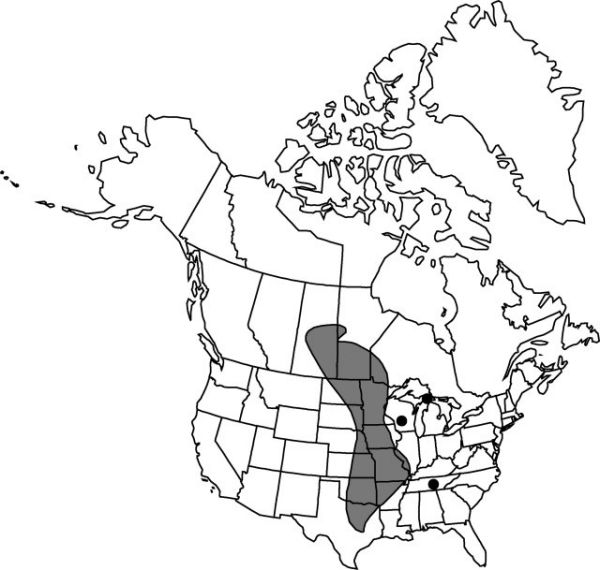Allium stellatum
Bot. Mag. 38: plate 1576. 1813.
Bulbs 1–5+, usually clustered, often short-rhizomatous at base, rhizome not stout or iris-like, ovoid, 2–4 × 1–2.5 cm; outer coats enclosing 1 or more bulbs, grayish or brownish, membranous, fibers parallel, few, or sometimes reticulate, cells obscure, finely meshed; inner coats whitish to pinkish, cells obscure, ± quadrate. Leaves persistent, green at anthesis, 3–5, basally sheathing, sheaths never extending much above soil level; blade solid, flat, channeled, 14–35 cm × 1–5 mm, margins ± entire. Scape persistent, solitary, erect, or, if nodding at anthesis, becoming erect, solid, terete or ± 4-angled, particularly distally, 20–50 cm × 1–3.5 mm. Umbel persistent, nodding, becoming erect, ± loose, 9–40-flowered, hemispheric, bulbils unknown; spathe bracts persistent, 2, 2–4-veined, lanceolate, ± equal, apex acuminate. Flowers stellate, 5–8 mm; tepals spreading, deep pink, elliptic-lanceolate, ± equal, withering in fruit, margins entire, apex acute, midribs not thickened; stamens exserted; anthers yellow; pollen yellow; ovary conspicuously crested; processes 6, distinct, flattened, ± triangular, margins entire or toothed; style exserted, linear, ± equaling stamens; stigma capitate, scarcely thickened, unlobed; pedicel 0–20 mm. Seed coat dull; cells minutely roughened. 2n = 14.
Phenology: Flowering Jul–Oct.
Habitat: Often on calcareous soils
Elevation: 300–2200 m
Distribution

Man., Ont., Sask., Ark., Ill., Iowa, Kans., Mich., Minn., Mo., Nebr., N.Dak., Okla., S.Dak., Tenn., Tex., Wis.
Discussion
Selected References
None.